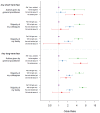COVID-19 Vaccines: Fear of Side Effects among German Health Care Workers
- PMID: 35632445
- PMCID: PMC9146316
- DOI: 10.3390/vaccines10050689
COVID-19 Vaccines: Fear of Side Effects among German Health Care Workers
Abstract
(1) Background: Health care workers (HCWs) play a key role in increasing anti-COVID vaccination rates. Fear of potential side effects is one of the main reasons for vaccine hesitancy. We investigated which side effects are of concern to HCWs and how these are associated with vaccine hesitancy. (2) Methods: Data were collected in an online survey in February 2021 among HCWs from across Germany with 4500 included participants. Free-text comments on previously experienced vaccination side effects, and fear of short- and long-term side effects of the COVID-19 vaccination were categorized and analyzed. (3) Results: Most feared short-term side effects were vaccination reactions, allergic reactions, and limitations in daily life. Most feared long-term side effects were (auto-) immune reactions, neurological side effects, and currently unknown long-term consequences. Concerns about serious vaccination side effects were associated with vaccination refusal. There was a clear association between refusal of COVID-19 vaccination in one's personal environment and fear of side effects. (4) Conclusions: Transparent information about vaccine side effects is needed, especially for HCW. Especially when the participants' acquaintances advised against vaccination, they were significantly more likely to fear side effects. Thus, further education of HCW is necessary to achieve good information transfer in clusters as well.
Keywords: COVID-19; fears; health care workers; side-effects; vaccine hesitancy.
Conflict of interest statement
The authors declare no conflict of interest. Joerg Meerpohl is Member of the Ständige Impfkommission (STIKO)—Standing Commission on Vaccination at the Robert-Koch-Institute in Germany.
Figures










References
-
- Verity R., Okell L.C., Dorigatti I., Winskill P., Whittaker C., Imai N., Cuomo-Dannenburg G., Thompson H., TWalker P.G., Fu H., et al. Estimates of the severity of coronavirus disease 2019: A model-based analysis. Lancet Infect. Dis. 2020;20:669–677. doi: 10.1016/S1473-3099(20)30243-7. - DOI - PMC - PubMed
-
- Eichner M. In: Berichtüber Die Erstellung Einer Strukturierten Literaturrecherche zur Rolle der Geimpften am SARS-CoV-2-Pandemiegeschehen. Epimos GmbH, editor. Ministerium für Soziales, Gesundheit und Integration Baden-Württemberg; Stuttgart, Germany: 2021.
-
- Siciliani L., Wild C., McKee M., Kringos D., Barry M.M., Barros P.P., Maeseneerg J., Murauskieneh L., Ricciardii W., On behalf of the members of the Expert Panel on Effective Ways of Investing in Health Strengthening vaccination programmes and health systems in the European Union: A framework for action. Health Policy. 2020;124:511–518. doi: 10.1016/j.healthpol.2020.02.015. - DOI - PubMed
Grants and funding
LinkOut - more resources
Full Text Sources

